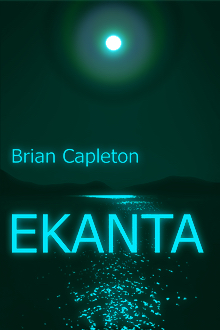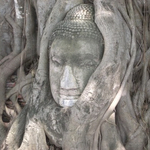
Ekanta
Luke is seeking escape by exploring a new coastline formed after a cataclysm that changed even the geography of the Old World. A careless mistake leads to a near fatal accident that results in him being brought to an island community where he finds himself increasingly drawn into an unfolding prophecy.
About
New Edition, new version, extensively revised, expanded and reformatted.
9 X 6 inches
380 pages
Ekanta has had some previous, different incarnations, both with the same name, and a different name. The new edition is extensively re-worked, revised, corrected and extended, such that it is a completely new version.
380 pages
Ekanta has had some previous, different incarnations, both with the same name, and a different name. The new edition is extensively re-worked, revised, corrected and extended, such that it is a completely new version.



Genre & Synopsis
Genre: Mythic Symbolism / Hindu and Buddhist context
Synopsis:
Synopsis:
Ekanta is a story of Mythic Symbolism. Although nonsectarian it is woven with Hindu and Buddhist allusions. The word Ekanta itself means both a secret place of peace and solitude, and the error of believing that there is only one true path or religion.
Luke is seeking escape by exploring a new coastline formed after a cataclysm that changed even the geography of the Old World. A careless mistake leads to a near fatal accident that results in him being brought to an island community - the Ekanta - where he finds himself increasingly drawn into an unfolding prophecy.
Most groups in the Ekanta are concerned with seeing what is going on around them according to the their various belief systems. Binding all together is the Prophecy from the original spiritual Order on the island, now adopted by the Foundation that has built the Ekanta.
The Prophesy tells of the reincarnation of Lalitchandra, which is to take place in the Ekanta. However, all is not what it seems. Entangled with the Prophesy is also a Covenant by which the parents of the prophesised child will receive a huge part of the immense wealth under the control of the Foundation.
As the residents of the Ekanta approach the next full moon, their conflicting intentions and beliefs about the prophecy begin to play themselves out, and Luke finds himself unexpectedly caught at the very centre of what is happening.
As the story progresses towards its climax, the psychological space in which the events take place becomes more and more removed from normality. With an increasing blurring of the distinction between inner experience and actuality, a story of love, death, and relationships, develops. Together with the sheer power of nature, all the elements weave themselves together in a story that is more a "who will it be"? than a "whodunit".
Luke is seeking escape by exploring a new coastline formed after a cataclysm that changed even the geography of the Old World. A careless mistake leads to a near fatal accident that results in him being brought to an island community - the Ekanta - where he finds himself increasingly drawn into an unfolding prophecy.
Most groups in the Ekanta are concerned with seeing what is going on around them according to the their various belief systems. Binding all together is the Prophecy from the original spiritual Order on the island, now adopted by the Foundation that has built the Ekanta.
The Prophesy tells of the reincarnation of Lalitchandra, which is to take place in the Ekanta. However, all is not what it seems. Entangled with the Prophesy is also a Covenant by which the parents of the prophesised child will receive a huge part of the immense wealth under the control of the Foundation.
As the residents of the Ekanta approach the next full moon, their conflicting intentions and beliefs about the prophecy begin to play themselves out, and Luke finds himself unexpectedly caught at the very centre of what is happening.
As the story progresses towards its climax, the psychological space in which the events take place becomes more and more removed from normality. With an increasing blurring of the distinction between inner experience and actuality, a story of love, death, and relationships, develops. Together with the sheer power of nature, all the elements weave themselves together in a story that is more a "who will it be"? than a "whodunit".
Look Inside
Chapters are missing from this sample
Chapters are missing from this sample
END OF SAMPLE
Did you know?
Did you know?
Lunaception - which is the synchronising of female fertility with the phases of the moon - is a term originally used by Louise Lacey in her book of that name.
The corpse flower (Amorphophallus titanum) is a real plant, that does have the features and characteristics of sex and death, as described in Ekanta.
The Auspicious Symbols of Buddhism appear tacitly woven into the story as things and features.
The Samudra Mathana (samudramathana) that Inesh mentions in the story, is itself a story in the Indian Puranas, and means 'The Churning of the Ocean'.
The Ketaki tree whose flower appears twice in the story, is a real tree - Pandanus odorifer. It is also known as the fragrant screw pine, is found in subtropical coastal regions, and is one kind of tree likely to grow in the landscape after geographical disturbances such as earthquakes.
The Ketaki flower appears in the Indian Puranas where it features in the story of the dispute between Viśnu and Brahma. In the story, Śiva appears on the field of battle or dispute between Viśnu and Brahma, in the form of an infinite column of fire, called the Linga. Brahma and Viśnu go in search of the origins of this Linga, Viśnu going downwards in the form of a boar, and Brahma going upwards, having taken the form of a swan.
Neither can find the origin of the Linga, because it is infinite. However, on his way up Brahma encounters an innocent Ketaki flower falling on its way down. The flower has no idea where it has come from. In a bid to beat Viśnu, Brahma persuades the Ketaki flower to bear false witness that he had reached the top of the column.
Brahma originally had five heads, and as a result of his attempted deception Śiva chopped off the fifth head, leaving him with the four heads in the popular imagery of him.
It is this story that Chandrika refers to, when she and Luke are resting on the way up to the top of the crag, The Ends of the Earth.
In the Indian Puranas Brahma also creates an egg, from which existence is created. This is alluded to when Chandrika and Luke are sitting in the gardens towards the end of the story.
The Ketaki flower appears in the Indian Puranas where it features in the story of the dispute between Viśnu and Brahma. In the story, Śiva appears on the field of battle or dispute between Viśnu and Brahma, in the form of an infinite column of fire, called the Linga. Brahma and Viśnu go in search of the origins of this Linga, Viśnu going downwards in the form of a boar, and Brahma going upwards, having taken the form of a swan.
Neither can find the origin of the Linga, because it is infinite. However, on his way up Brahma encounters an innocent Ketaki flower falling on its way down. The flower has no idea where it has come from. In a bid to beat Viśnu, Brahma persuades the Ketaki flower to bear false witness that he had reached the top of the column.
Brahma originally had five heads, and as a result of his attempted deception Śiva chopped off the fifth head, leaving him with the four heads in the popular imagery of him.
It is this story that Chandrika refers to, when she and Luke are resting on the way up to the top of the crag, The Ends of the Earth.
In the Indian Puranas Brahma also creates an egg, from which existence is created. This is alluded to when Chandrika and Luke are sitting in the gardens towards the end of the story.
The name Inesh means "king of kings" and is associated with Viśnu.
The name Chandrika means "moonlight".
The name Mohini means "infatuating", or "enchanting". It is also the name of the only female avatar of Viśnu.
The name Amrit is derived from Amrta in Sanskrit, meaning "nectar of immortality". When Amrit says "you are going to die" to the mask in the fight scene, he is literally just stating a fact, rather than making a threat.
Ekanta is a Sanskrit word referring to the folly of inflexibly believing that any particular belief or teaching is a literal or absolute representation of the Truth.
This principle appears both in Jainism and in the Samaññaphala Sutta (The Fruits of the Contemplative Life) of Buddhism.
The word Ekanta itself means both this "wrong belief", and a secret place of peace and solitude.
This principle appears both in Jainism and in the Samaññaphala Sutta (The Fruits of the Contemplative Life) of Buddhism.
The word Ekanta itself means both this "wrong belief", and a secret place of peace and solitude.
Content and Suitability
Content, Suitability, and Provenance
Ekanta has had some previous, different incarnations, both with the same name, and a different name. The new edition is extensively re-worked, revised, corrected and extended, such that it is a completely new version.
The story contains non-explicit adult themes. There is no strong language. It includes a section where there is a fight, and some symbolic elements that some people might consider frightening. However, the overall context is one of mythic symbolism.
Ekanta has had some previous, different incarnations, both with the same name, and a different name. The new edition is extensively re-worked, revised, corrected and extended, such that it is a completely new version.
The story contains non-explicit adult themes. There is no strong language. It includes a section where there is a fight, and some symbolic elements that some people might consider frightening. However, the overall context is one of mythic symbolism.